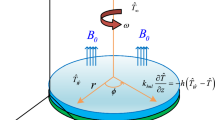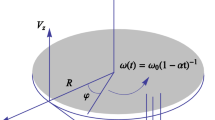Abstract
The thermodynamic features of the Reiner-Rivlin nanoliquid flow induced by a spinning disk are analyzed numerically. The non-homogeneous two-phase nanofluid model is considered to analyze the effect of nanoparticles on the thermodynamics of the Reiner-Rivlin nanomaterial, which also includes a temperature-dependent heat source (THS) and an exponential space-dependent heat source (ESHS). Further, the transfer of heat and mass is analyzed with velocity slip, volume fraction jump, and temperature jump boundary conditions. The finite difference method-based routine is used to solve the complicated differential equations formed after using the von-Karman similarity technique. Limiting cases of the present problem are found to be in good agreement with benchmarking studies. The relationship of the pertinent parameters with the heat and mass transport is scrutinized using correlation, which is further evaluated based on the probable error estimates. Multivariable models are fitted for the friction factor at the disk and heat transport, which accurately predict the dependent variables. The Reiner-Rivlin nanoliquid temperature is influenced comparatively more by the ESHS than by the THS. The Nusselt number is decreased by the ESHS and THS, whereas the friction factor at the disk is predominantly decremented by the wall roughness aspect. The increment in the non-Newtonian characteristic of the liquid leads more fluid to drain away in the radial direction far from the disk compared with the fluid nearby the disk in the presence of the centrifugal force during rotation. The increased thermal and volume fraction slip lowers the nanoliquid temperature and nanoparticle volume fraction profiles.
Similar content being viewed by others
Abbreviations
- u, v, w :
-
velocity components (m·s−1)
- T :
-
fluid temperature (K)
- c :
-
nanoparticle volume fraction
- q T :
-
linear heat source factor (J·m−3·K−1·s−1)
- q E :
-
exponential space-dependent heat source (ESHS) factor (J · m−3 · K−1 · s−1)
- r, ϕ, z :
-
cylindrical coordinates
- T w :
-
temperature of the fluid near the disk (K)
- T ∞ :
-
temperature of the ambient fluid (K)
- c w :
-
nanoparticle volume fraction near the disk
- c ∞ :
-
ambient nanoparticle volume fraction
- D T :
-
thermophoretic diffusion coefficient (m2 · s−1)
- D B :
-
Brownian diffusion coefficient (m2 · s−1)
- Pr :
-
Prandtl number
- (ρc p)f :
-
heat capacity of the fluid (J · m−3 · K−1)
- (ρc p)p :
-
heat capacity of nanoparticles (J·m−3 · K−1)
- P :
-
pressure (N · m−2)
- q w :
-
heat flux near the disk (W · m−2)
- N t :
-
thermophoresis parameter
- N B :
-
Brownian motion parameter
- Q T :
-
linear heat source parameter
- Q E :
-
exponential heat source parameter
- Re :
-
Reynolds number
- C f :
-
skin friction coefficient
- C (ζ):
-
dimensionless nanoparticle volume fraction
- k :
-
thermal conductivity (W · m−1 · K−1)
- Nu :
-
Nusselt number
- K :
-
material parameter of the Reiner-Rivlin fluid
- Sc :
-
Schmidt number
- F (ζ):
-
dimensionless axial velocity component
- F′(ζ):
-
dimensionless radial velocity component
- G(ζ):
-
dimensionless azimuthal velocity component
- n :
-
dimensionless exponential index
- Le :
-
Lewis number
- ν f :
-
kinematic viscosity (m2 · s−1)
- α m :
-
thermal diffusivity (m2 · s−1)
- θ(ζ):
-
dimensionless temperature
- μ f :
-
dynamic viscosity (kg · m−1 · s−1)
- ρ f :
-
density(kg · m−3)
- β 1, β 2, ν 3, ν 4 :
-
coefficients of radial, azimuthal, thermal, and nanoparticle volume fraction slip
- ω :
-
angular velocity (m · s−1)
- μ c :
-
cross-viscosity coefficient
- γ :
-
thermal slip parameter
- δ :
-
nanoparticle volume fraction slip parameter
- λ 1, λ 2 :
-
wall slip parameters
- τ ij :
-
stress tensors
References
CHOI, S. U. S. and EASTMAN, J. A. Enhancing thermal conductivity of fluids with nanoparticles. Proceedings of the 1995 International Mechanical Engineering Congress and Exposition, ASME, San Francisco, 66, 99–105 (1995)
KHO, Y. B., HUSSANAN, A., MOHAMED, M. K. A., and SALLEH, M. Z. Heat and mass transfer analysis on flow of Williamson nanofluid with thermal and velocity slips: Buongiorno model. Propulsion and Power Research, 8, 243–252 (2019)
AHMED, S. E. and RASHED, Z. Z. MHD natural convection in a heat generating porous medium-filled wavy enclosures using Buongiorno’s nanofluid model. Case Studies in Thermal Engineering, 14, 100430 (2019)
SHEIKHOLESLAMI, M., CHAMKHA, A. J., RANA, P., and MORADI, R. Combined thermophoresis and Brownian motion effects on nanofluid free convection heat transfer in an L-shaped enclosure. Chinese Journal of Physics, 55, 2356–2370 (2017)
HAFEEZ, A., KHAN, M., and AHMED, J. Stagnation point flow of radiative Oldroyd-B nanofluid over a rotating disk. Computer Methods and Programs in Biomedicine, 191, 105342 (2020)
TABASSUM, M. and MUSTAFA, M. A numerical treatment for partial slip flow and heat transfer of non-Newtonian Reiner-Rivlin fluid due to rotating disk. International Journal of Heat and Mass Transfer, 123, 979–987 (2018)
DAS, A. and SAHOO, B. Flow of a Reiner-Rivlin fluid between two infinite coaxial rotating disks. Mathematical Methods in the Applied Sciences, 41, 5602–5618 (2018)
SAHOO, B. and SHEVCHUK, I. V. Heat transfer due to revolving flow of Reiner-Rivlin fluid over a stretchable surface. Thermal Science and Engineering Progress, 10, 327–336 (2019)
NAQVI, S., KIM, H. M., MUHAMMAD, T., MALLAWI, F., and ULLAH, M. Z. Numerical study for slip flow of Reiner-Rivlin nanofluid due to a rotating disk. International Communications in Heat and Mass Transfer, 116, 104643 (2020)
TANVEER, A., SALAHUDDIN, T., KHAN, M., ALSHOMRANI, A. S., and MALIK, M. Y. The assessment of nanofluid in a von Karman flow with temperature relied viscosity. Results in Physics, 9, 916–922 (2018)
QAYYUM, S., HAYAT, T., KHAN, M. I., KHAN, M. I., and ALSAEDI, A. Optimization of entropy generation and dissipative nonlinear radiative von Karman’s swirling flow with Soret and Dufour effects. Journal of Molecular Liquids, 262, 261–274 (2018)
NAGANTHRAN, K., MUSTAFA, M., MUSHTAQ, A., and NAZAR, R. Dual solutions for fluid flow over a stretching/shrinking rotating disk subject to variable fluid properties. Physica A: Statistical Mechanics and Its Applications, 556, 124773 (2020)
ZANGOOEE, M. R., HOSSEINZADEH, K., and GANJI, D. D. Hydrothermal analysis of MHD nanofluid (TiO2-GO) flow between two radiative stretchable rotating disks using AGM. Case Studies in Thermal Engineering, 14, 100460 (2019)
KHAN, M., HAFEEZ, A., and AHMED, J. Impacts of non-linear radiation and activation energy on the axisymmetric rotating flow of Oldroyd-B fluid. Physica A: Statistical Mechanics and Its Applications, 124085 (2020)
HAYAT, T., AHMAD, S., KHAN, M. I., and ALSAEDI, A. Modeling and analyzing flow of third grade nanofluid due to rotating stretchable disk with chemical reaction and heat source. Physica B: Condensed Matter, 537, 116–126 (2018)
AZIZ, A., ALSAEDI, A., MUHAMMAD, T., and HAYAT, T. Numerical study for heat generation/absorption in flow of nanofluid by a rotating disk. Results in Physics, 8, 785–792 (2018)
HAYAT, T., MUHAMMAD, T., SHEHZAD, S. A., and ALSAEDI, A. An analytical solution for magnetohydrodynamic Oldroyd-B nanofluid flow induced by a stretching sheet with heat generation/absorption. International Journal of Thermal Sciences, 111, 274–288 (2017)
JAMALUDIN, A., NAGANTHRAN, K., NAZAR, R., and POP, I. MHD mixed convection stagnation-point flow of Cu-Al2O3/water hybrid nanofluid over a permeable stretching/shrinking surface with heat source/sink. European Journal of Mechanics/B Fluids, 84, 71–80 (2020)
MAHANTHESH, B., MACKOLIL, J., and SHEHZAD, S. A. Statistical analysis of stagnationpoint heat flow in Williamson fluid with viscous dissipation and exponential heat source effects. Heat Transfer, 49, 4580–4591 (2020)
TIAN, J. H. and JIANG, K. Heat conduction investigation of the functionally graded materials plates with variable gradient parameters under exponential heat source load. International Journal of Heat and Mass Transfer, 122, 22–30 (2018)
GIREESHA, B. J., KUMAR, P. B. S., MAHANTHESH, B., SHEHZAD, S. A., and ABBASI, F. M. Nonlinear gravitational and radiation aspects in nanoliquid with exponential space dependent heat source and variable viscosity. Microgravity Science and Technology, 30, 257–264 (2018)
MAHANTHESH, B., SHASHIKUMAR, N. S., GIREESHA, B. J., and ANIMASAUN, I. L. Effectiveness of Hall current and exponential heat source on unsteady heat transport of dusty TiO2-EO nanoliquid with nonlinear radiative heat. Journal of Computational Design and Engineering, 6, 551–561 (2019)
AHMED, A., KHAN, M., and AHMED, J. Thermal analysis in swirl motion of Maxwell nanofluid over a rotating circular cylinder. Applied Mathematics and Mechanics (English Edition), 41(9), 1417–1430 (2020) https://doi.org/10.1007/s10483-020-2643-7
ZAINAL, N. A., NAZAR, R., NAGANTHRAN, K., and POP, I. Impact of anisotropic slip on the stagnation-point flow past a stretching/shrinking surface of the Al2O3-Cu/H2O hybrid nanofluid. Applied Mathematics and Mechanics (English Edition), 41(9), 1401–1416 (2020) https://doi.org/10.1007/s10483-020-2642-6
LIU, H., ANIMASAUN, I. L., SHAH, N. A., KORIKO, O. K., and MAHANTHESH, B. Further discussion on the significance of quartic autocatalysis on the dynamics of water conveying 47 nm alumina and 29 nm cupric nanoparticles. Arabian Journal for Science and Engineering, 45, 5977–6004 (2020)
SABU, A. S., MATHEW, A., NEETHU, T. S., and ANIL GEORGE, K. Statistical analysis of MHD convective ferro-nanofluid flow through an inclined channel with Hall current, heat source and Soret effect. Thermal Science and Engineering Progress, 22, 100816 (2021)
FISHER, R. A. On the “probable error” of a coefficient of correlation deduced from a small sample. Metron, 1, 1–32 (1921)
Acknowledgement
The authors thank the anonymous reviewers and the editors for their constructive comments that improved the quality of the manuscript.
Author information
Authors and Affiliations
Corresponding author
Rights and permissions
About this article
Cite this article
Sabu, A.S., Mackolil, J., Mahanthesh, B. et al. Reiner-Rivlin nanomaterial heat transfer over a rotating disk with distinct heat source and multiple slip effects. Appl. Math. Mech.-Engl. Ed. 42, 1495–1510 (2021). https://doi.org/10.1007/s10483-021-2772-7
Received:
Revised:
Published:
Issue Date:
DOI: https://doi.org/10.1007/s10483-021-2772-7
Key words
- rotating surface
- Reiner-Rivlin fluid
- nanomaterial
- exponential space-based heat source
- multiple slip effect
- regression analysis




